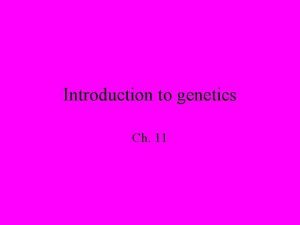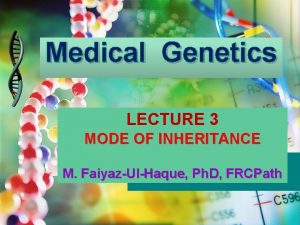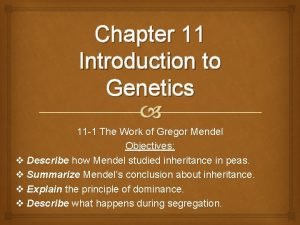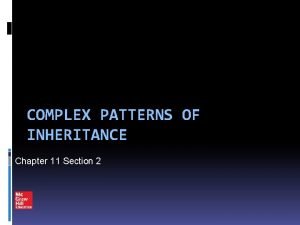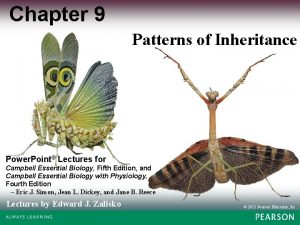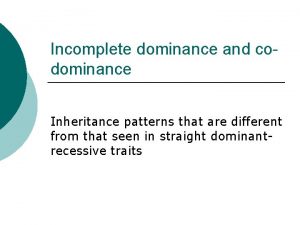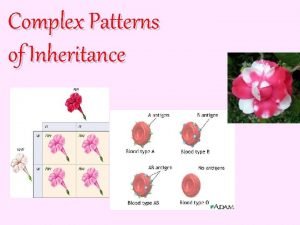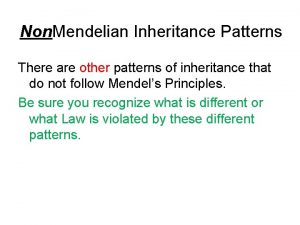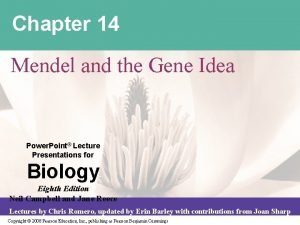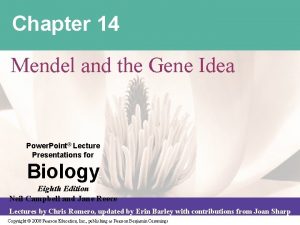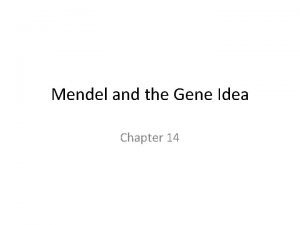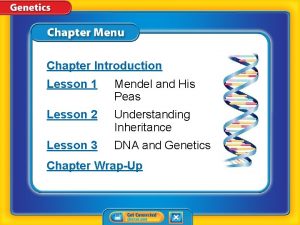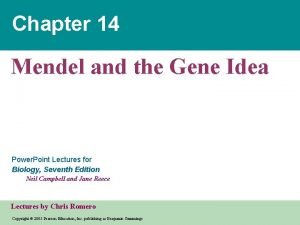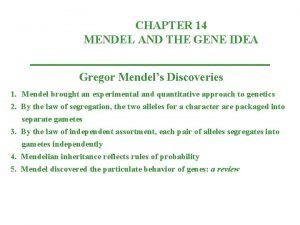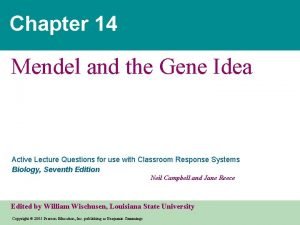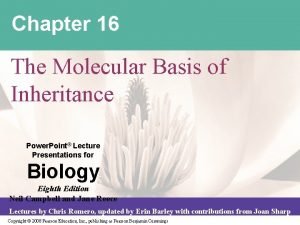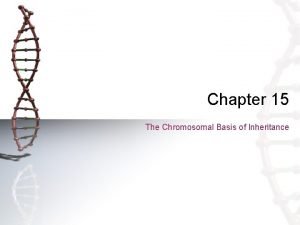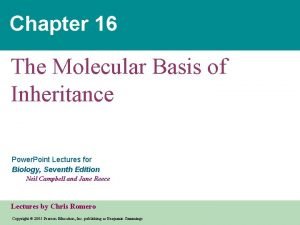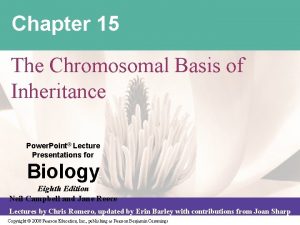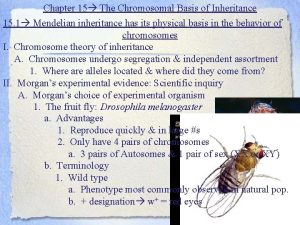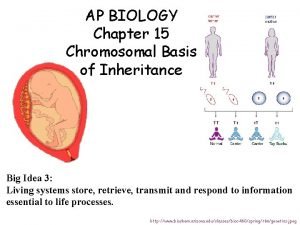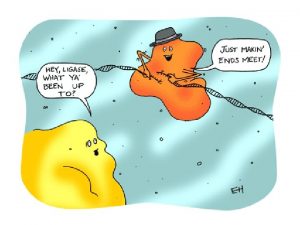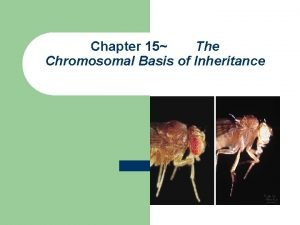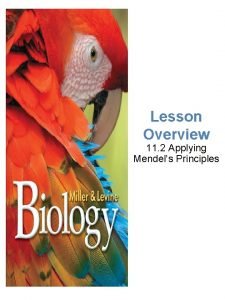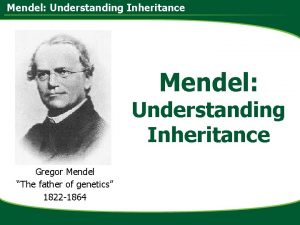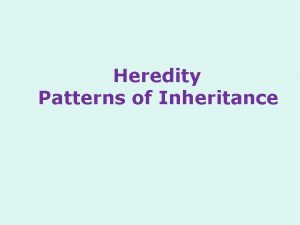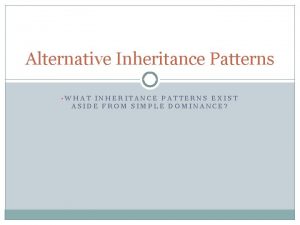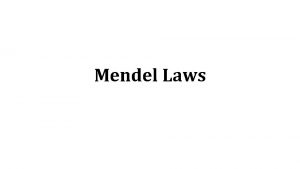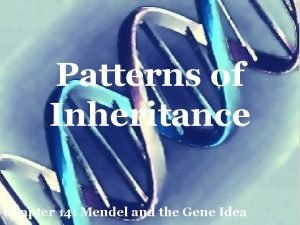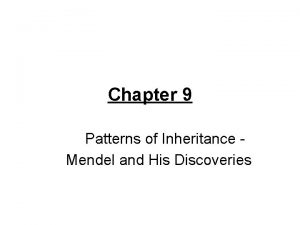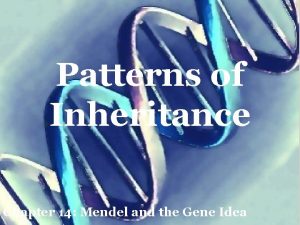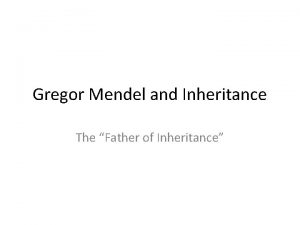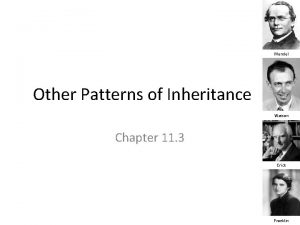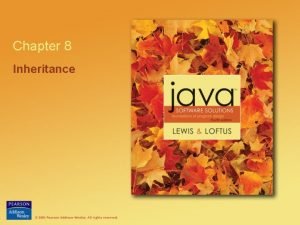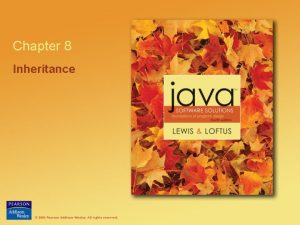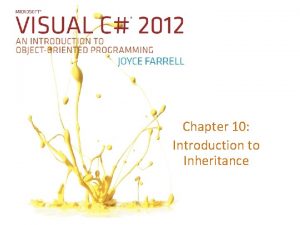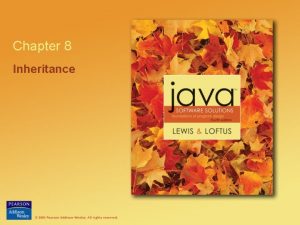Patterns of Inheritance Chapter 14 Mendel and the

































- Slides: 33

Patterns of Inheritance Chapter 14: Mendel and the Gene Idea

Patterns of Inheritance FParents and offspring often share observable traits. FGrandparents and grandchildren may share traits not seen in parents. FWhy do traits disappear in one generation and reappear in another?

Possible Hypotheses F The states that genetic material from the two parents blends together • Example: Blue and yellow paint blend to make green F The states that parents pass on discrete heritable units • These heritable units are that can be passed on to the next generation F Gregor Mendel documented a particulate mechanism through his experiments with garden peas

Gregor Mendel �� FAustrian monk FAnalyzed • Asked why • Tested his theories making predictions based on math • Worked with garden peas

Pea plants Pisum sativum F Advantages of pea plants for genetic study: • Many varieties with distinct heritable features, or (such as flower color) § Character variants (such as purple or white flowers) are called • Mating of plants can be controlled • Each pea plant has spermproducing organs (stamens) and egg-producing organs (carpels) • Cross-pollination (fertilization between different plants) easily done

Traits Mendel used

True breeding plants FBegan with truebreeding varieties • Self-pollinate • Always produce same offspring F Crossed with other true -breeding variety • Offspring called

Generations F Mendel mated two contrasting, true-breeding varieties • Process called F The true-breeding parents are the F The hybrid offspring of the P generation are called the • Referred to as hybrids F When F 1 individuals selfpollinate, the is produced

Crosses F Had lots of varieties • 7 traits with two forms of each trait F Crossing a tall plant with a short plant is a • A monohybrid cross is involving only F Trait - plant height • Two variations - tall and short F Generations • P - parental (true-breeding): tall & short • F 1 - first filial or son (children): all tall • F 2 - next generation (grandkids): tall & short F What happened? How did the short plants reappear?


Mendel’s Conclusions 1. Alternative versions of genes account for variations in inherited characters F For example, the gene for flower color in pea plants exists in two versions: purple flowers and white flowers F These alternative versions of a gene are now called F Each gene resides at a specific (location on a specific chromosome) F Therefore, we distinguish between an organism’s • or physical appearance • or genetic makeup

Alleles

Genotype Terminology FIf alleles are identical = • If both alleles are recessive = § Genotype is aa • If both alleles are dominant = § Genotype is AA FIf both alleles are different = • Dominant phenotype expressed • One dominant allele and one recessive allele (Aa) FAn organism’s traits do not always reveal its genetic composition


Mendel’s Conclusions 2. For each character, an organism inherits two alleles, one from each parent F Factors (genes) that determine traits can be hidden or unexpressed. F Alleles may be identical (true-breeding plants) or different (F 1 hybrids) • traits expressed in the F 1 generation • traits not expressed in the F 1 generation F Mendel observed the same pattern of inheritance in 7 pea plant characters, each represented by two traits F What Mendel called a “heritable factor” is what we now call a gene

Mendel’s Conclusions 3. If two alleles at a locus differ, then one (dominant allele) determines the organism’s appearance, and the other (recessive allele) has no noticeable effect on appearance F When Mendel crossed contrasting, true-breeding white and purple flowered pea plants, all of the F 1 hybrids were purple F When Mendel crossed the F 1 hybrids, many of the F 2 plants had purple flowers, but some had white F Mendel discovered a ratio of about three to one, purple to white flowers, in the F 2 generation


Mendel’s Law of Segregation 4. The law of segregation states that the two alleles for a heritable character segregate (separate) during gamete formation and end up in different gametes F Thus, an egg or a sperm gets only one of the two alleles that are present in the somatic cells of an organism F This segregation of alleles corresponds to the distribution of homologous chromosomes to different gametes in meiosis

Principle of Segregation 1. Two copies of each trait (gene) • Fully expressed gene dominant • Other gene - recessive 2. Gametes only have (haploid) 3. Fertilization copies (diploid)


Monohybrid & Dihybrid Crosses FMendel derived the law of segregation by following a single character FMendel identified his second law of inheritance by following two characters at the same time FCrosses involving two traits are called FA dihybrid cross can determine whether two characters are transmitted to offspring as a package or independently FUsing a dihybrid cross, Mendel developed the law of

Law of Independent Assortment F The law of independent assortment states that each pair of alleles segregates independently of each other pair of alleles during gamete formation F This law applies only to genes on different, nonhomologous chromosomes F Genes located near each other on the same chromosome tend to be inherited together

Probability Rules F Mendel’s laws reflect the rules of probability F When tossing a coin, the outcome of one toss has no impact on the outcome of the next toss F In the same way, the alleles of one gene separate into gametes independently of another gene’s alleles F The states that the probability that two or more independent events will occur together is the product of their individual probabilities F Example: probability of 2 coins landing heads up is 1/4 (1/2 x 1/2 = 1/4)

Probability Rules F Each gamete has a chance of carrying the dominant allele and a chance of carrying the recessive allele • Similar to heads and tails F Another rule is needed to figure out the probability that an F 2 plant from a monohybrid cross will be heterozygous rather than homozygous F The rule of states that the probability that any one of two or more exclusive events will occur is calculated by adding together their individual probabilities F Example: probability of one heads & one tails is 1/2 (1/4 + 1/4 = 1/2)

Probability Rules F These rules can be used to predict the outcome of crosses involving multiple characters F A dihybrid or other multicharacter crosses are equivalent to two or more independent monohybrid crosses occurring simultaneously F In calculating the chances for various genotypes, each character is considered separately, and then the individual probabilities are multiplied together

Punnett squares F Probability can be depicted through the use of a • A diagram for predicting the results of a genetic cross between individuals of known genetic makeup F Predicts all possible offspring for all possible gametes with random fertilization F Same letter used for trait • Capital letter = dominant allele (A) • Lower case letter = recessive allele (a)

Setting up a Punnett Square F Step 1. Designate letters which will represent the genes/traits. • T = tall t = short F Step 2. Write down the genotypes (genes) of each parent. These are often given to you or are possible to determine. • TT (tall) X tt (short) - both homozygous or purebred F Step 3. List the genes that each parent can contribute. Parent 1 Parent 2

Setting up a Punnett Square F Step 4. Draw a Punnett square and write the possible gene(s) of one parent across the top and of the other parent along the side. F Step 5. Fill in each box of the Punnett square by transferring the letter above and in front of each box into each appropriate box. As a general rule, the capital letter goes first and a lowercase letter follows. FStep 6. List the possible genotypes and phenotypes of the offspring for this cross. FGenotypic Ratio: FPhenotypic Ratio:

Practice! F 1. Cross a homozygous tall plant with a short plant. What are the genotypic and phenotypic ratios? F 2. Cross a heterozygous tall plant with a homozygous tall plant. What are the genotypic and phenotypic ratios? F 3. Cross a heterozygous tall plant with a short plant. What are the genotypic and phenotypic ratios?

Testcross F Used to determine exact genotype • Individual expressing dominant phenotype • Could be heterozygous or homozygous dominant F Cross with F Make prediction with Punnett square F If homozygous dominant: • TT x tt • All offspring Tt or tall plants F If heterozygous: • Tt x tt • Offspring - half Tt (tall), half tt (short)


More Practice!!! 1. In rabbits, the allele for black fur (B) is dominant over the allele for brown fur (b). If a heterozygous male mates with a heterozygous female, what are the chances that the offspring will have black fur? 2. In humans, dimples are dominant to no dimples. If a homozygous dominant man reproduces with a heterozygous female, what are the chances of having a child with no dimples? 3. In humans, freckles are dominant over no freckles. A man with freckles reproduces with a woman with freckles, but the children have no freckles. What chance did each child have for freckles? 4. If a man is homozygous for widow’s peak (dominant) reproduces with a woman homozygous for straight hairline (recessive), what are the chances of their children having a widow’s peak? A straight hairline? 5. In humans, pointed eyebrows (B) are dominant over smooth eyebrows (b). Mary’s father has pointed eyebrows, but she and her mother have smooth. What is the genotype of the father?

Review Questions 1. 2. 3. 4. 5. 6. 7. 8. 9. 10. Differentiate between the blending and particulate hypotheses of inheritance. Explain the importance of Gregor Mendel’s work with garden peas. Also, explain why he used garden peas. Define the following vocabulary associated with basic genetics: character, trait, hybrid, gene, allele, locus, genotype, phenotype, dominant, recessive, homozygous, & heterozygous. Differentiate between the P, F 1, and F 2 generations. Differentiate between monohybrid and dihybrid crosses. Explain Mendel’s four basic conclusions regarding inheritance patterns. Explain the three parts to the law of segregation. Explain the law of independent assortment. Properly construct a Punnett square for use in solving a genetics problem involving probability. Explain the idea of a testcross.
 Mendel's first and second law of inheritance
Mendel's first and second law of inheritance Mendel's 3rd law of inheritance
Mendel's 3rd law of inheritance What did mendel conclude determines biological inheritance
What did mendel conclude determines biological inheritance Mendel's experimental design
Mendel's experimental design Complete the punnett square
Complete the punnett square Hybrid vs purebred
Hybrid vs purebred Chapter 11 section 2: complex patterns of inheritance
Chapter 11 section 2: complex patterns of inheritance A gene locus is
A gene locus is Chapter 11 section 1 basic patterns of human inheritance
Chapter 11 section 1 basic patterns of human inheritance Chapter 11 section 1 basic patterns of human inheritance
Chapter 11 section 1 basic patterns of human inheritance Chapter 9 patterns of inheritance
Chapter 9 patterns of inheritance Codominant inheritance patterns
Codominant inheritance patterns Complex patterns of inheritance
Complex patterns of inheritance Mendelian inheritance patterns
Mendelian inheritance patterns Eclat algorithm
Eclat algorithm Chapter 11 complex inheritance and human heredity test
Chapter 11 complex inheritance and human heredity test Mendel and the gene idea chapter 14
Mendel and the gene idea chapter 14 Chapter 14 mendel and the gene idea
Chapter 14 mendel and the gene idea Chapter 14 mendel and the gene idea
Chapter 14 mendel and the gene idea Solid
Solid Mendel and the gene idea chapter 14
Mendel and the gene idea chapter 14 Chapter 14 mendel and the gene idea
Chapter 14 mendel and the gene idea Chapter 14 mendel and the gene idea
Chapter 14 mendel and the gene idea Dating serves several important functions that include:
Dating serves several important functions that include: Chapter 16 the molecular basis of inheritance
Chapter 16 the molecular basis of inheritance Chapter 15 the chromosomal basis of inheritance
Chapter 15 the chromosomal basis of inheritance Chapter 16 molecular basis of inheritance
Chapter 16 molecular basis of inheritance 15/16
15/16 The chromosomal basis of inheritance chapter 15
The chromosomal basis of inheritance chapter 15 Ap biology chapter 15
Ap biology chapter 15 Bioflix dna replication
Bioflix dna replication Chapter 15 the chromosomal basis of inheritance
Chapter 15 the chromosomal basis of inheritance Chapter 12 lesson 2 applying mendels principles
Chapter 12 lesson 2 applying mendels principles Chapter 12 lesson 1 the work of gregor mendel
Chapter 12 lesson 1 the work of gregor mendel
